Fifteen years ago, I wrote a story about poached beef tenderloin. Oddly, a story on the same subject by Mark Bittman appeared on the same day in a different newspaper. I promise there had been no collusion; I checked our e-mail conversations at the time, and nothing on the subject had arisen. It was coincidence, and a reminder that meat doesn’t need a hard sear to be appetizing.
With our respective beef tenderloins, both of us were aiming for rare or medium-rare meat, but traditional boiled meats (as in the Italian bollito misto I mentioned in my story and as in my mother’s boiled flanken – short ribs) are tougher cuts long-cooked until tender. They are simple and pure: even when poached in broth they taste cleanly of what they are without beating you about the head with pugnacious flavor. They’re relaxing.
When I last simmered a piece of meat, just the other week, it was a neatly tied pork coppa roast, cut from the top of the shoulder. Coppa comprises several muscles, with nice collagenous connective tissue and fat among them, and it makes an excellent braise in addition to lending itself to boiling. I brought to the boil a pot of water containing carrots, leeks, parsley, a bay leaf, a little salt and a scrap of dried kombu seaweed (never a bad idea for a cooking liquid) and cooked this for ten or fifteen minutes to flavor the water. I added the meat and simmered over low heat, partly covered, until tender, about 90 minutes (check after an hour: it should be slicing-tender, not falling apart into shreds). I transferred the meat to a container and strained the broth over it, then let it cool in that broth (which was delicious and a valuable byproduct of this meal: it is now frozen, and I plan to enrich it further with chicken, then use it as the basis for a clear soup). When it was cool, I stowed the container in the fridge overnight, which you don’t need to do depending on timing, though at least cooling the meat will make it easier to slice.
Cut thin, this would be an excellent room-temperature sandwich meat. Minced, it could end up in a tortellini filling (these could be served in the broth). But other plans were afoot.
I’d earlier cooked a batch of sauerkraut, more or less like this but with no bacon. Yes, there was to be bacon, but on the plate, not in the kraut: I simmered a chunk of smoky bacon – streaky, for UK readers – in some of that pork broth until tender, about 40 minutes, and saved the bacon broth separately. And one way in which my sauerkraut cooking has changed since 2008 is that I now add a small finely grated potato to the pot about half an hour before the kraut is done: this subtly thickens the liquid in a very appealing way.
I often “braise” quick-cooking meat in sauerkraut, things like chicken or pork tenderloin – or even fish – that I’ve browned and pan-cooked part-way through, then nestled into the sauerkraut to finish. This time, however, the meat would be fully cooked and would need only to be heated through. Shortly before dinner guests arrived, I cut the fridge-cold pork into thick portion-sized slices (what constitutes a portion is up to you), lightly browned it in a skillet, being very careful to salt it sufficiently: boiled pork needs this seasoning. I did the same with the chunk of boiled bacon. Meanwhile, I was heating the sauerkraut in a shallow pan presentable enough to bring to the table. When the meats were browned I arranged them in the sauerkraut pan, covered it and simmered for five minutes or so. At serving time, this took just a couple of minutes to reheat.
We ate our pork and bacon and sauerkraut with potato dumplings; steamed or boiled potatoes would have been equally good and far easier to prepare. Mustard was available, but didn’t seem to be necessary.
Even browned and re-simmered in the sauerkraut pan, the meat was quite different from a braised version of the same cut of pork. It had a denser consistency – not falling-apart tender, but more like a roast or steak – and a less complicated flavor, and was a successful companion to the aromatic, slightly sour cabbage. The bacon, of course, was bacon: salty, smoky and assertive, which provided a good contrast.
I can hardly wait to defrost the pork broth – after we get back from a two-week trip – and see what it gets turned into. Are tortellini in brodo too much to hope for? Hope not.
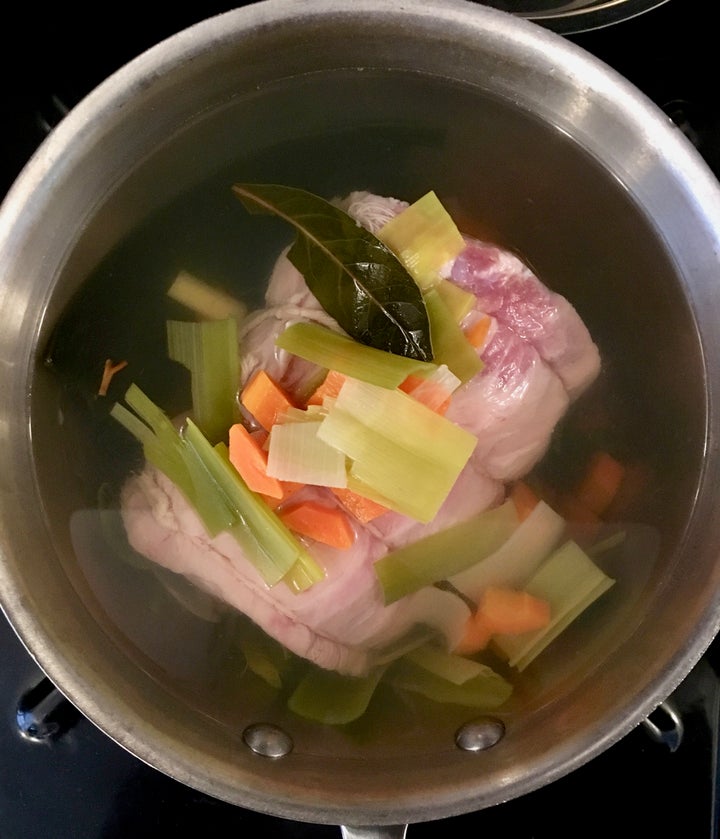
Rolled pork shoulder (coppa) about to be simmered
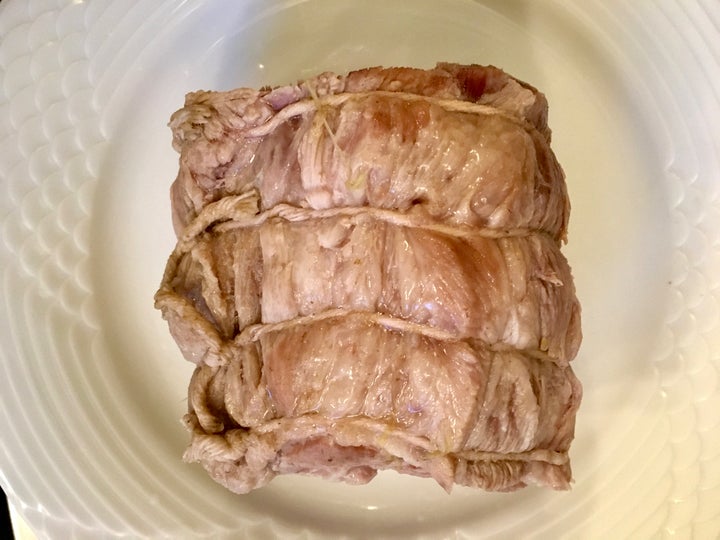
Simmered until tender but not falling apart
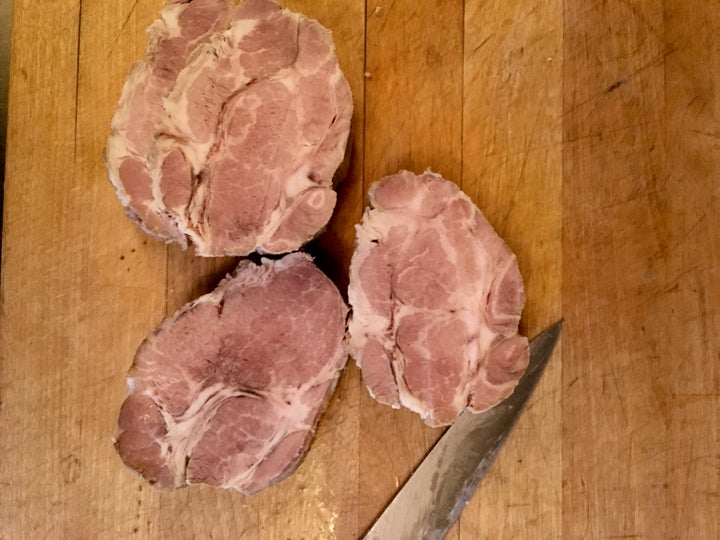
Cold pork cut into portions
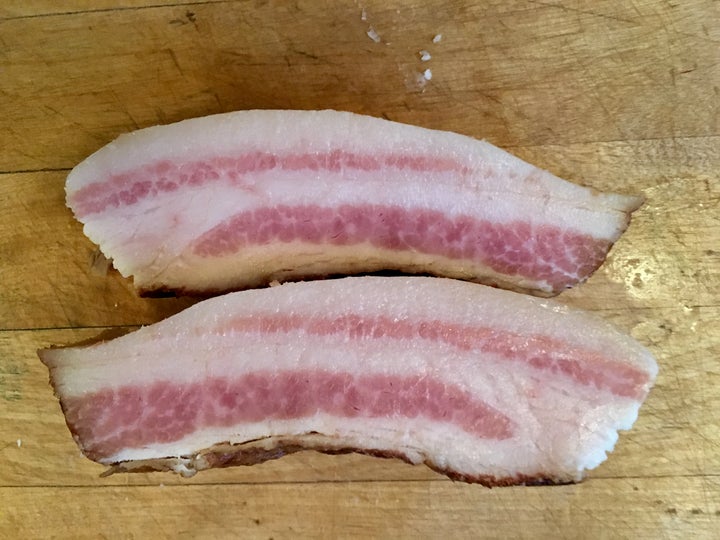
Likewise, smoky bacon
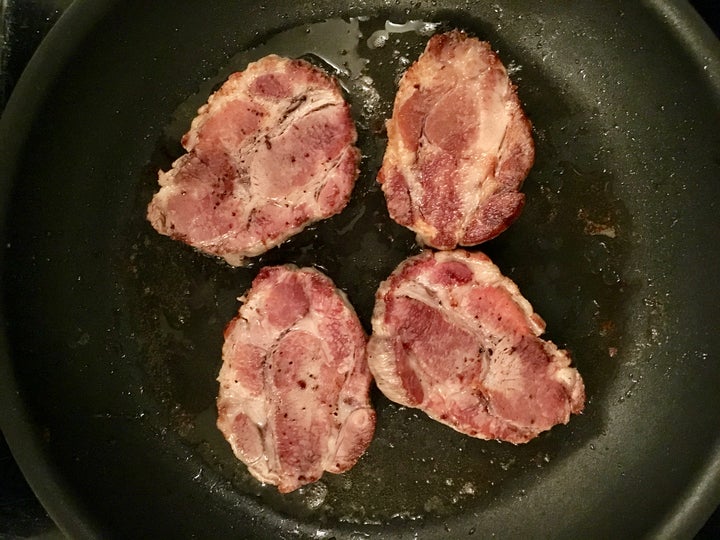
The pork, well seasoned and lightly browned
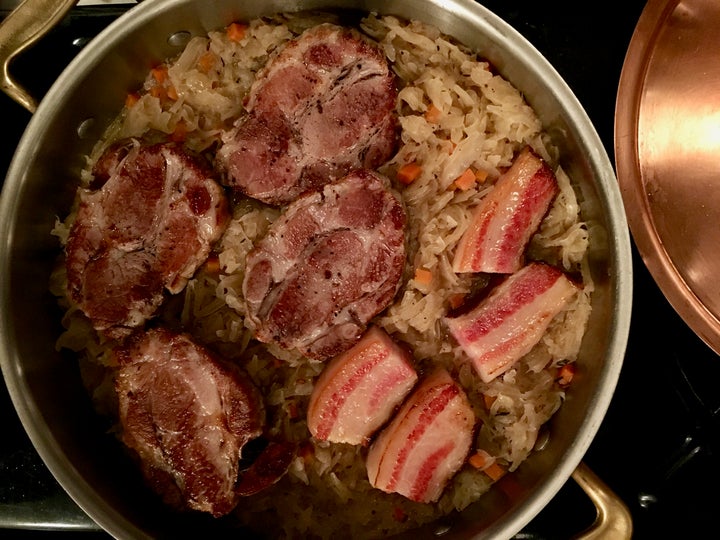
All together with the cooked sauerkraut